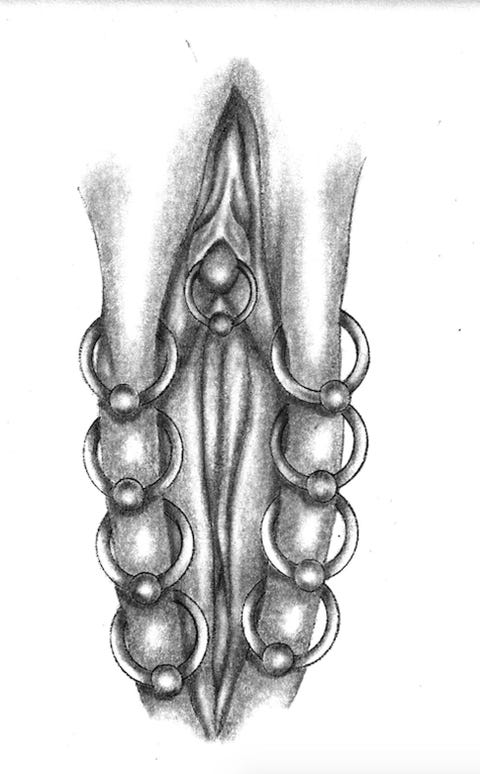Love , Sex and Relationships
Your Everything-to-Know Guide on Clitoral Piercings
While a genital piercing may not be as common or easy as getting your ears or belly button pierced, it is a very similar process. A small hole is placed and made to insert a ring, stud, or other piece of jewelry—sometimes for aesthetic purposes, and other times for pleasure.
For those with vulvas, you can get the piercing on the clitoris, the clitoral hood, or the labia, and for those with penises, you can get what’s called a Prince Albert piercing, which exists through the urethra and exits on the underside of the penis.
But before deciding on a genital piercing, you should do your homework and research a bit more about what to expect, how to properly treat your genital piercing, and other important things.
So for your pleasure, we’ve tapped Elayne Angel, a piercer who specializes in nipple and genital piercing and the author of The Piercing Bible: The Definitive Guide to Safe Body Piercing, to explain everything you need to know about clitoral piercings.
Your guide to all things genital piercing below. You’re welcome!
The different types of of clitoral piercings
First, it’s important to note that the term “clitoris piercing” is a bit hard to grasp and understand because clitoral glans piercings are super rare, says Angel. But clitoral hood piercings are super common.
However, since no two vulvas look alike, Angel says these piercings are all anatomically dependent. She recommends going to an expert who can consult you and guide your placement options to determine the best for you.
1. Vertical Clitoral Hood (VCH)
Angel says this piercing is the most popular among the clit piercings because many women are anatomically suited for it. With this piercing, the barbell passes through the clitoral hood vertically (like a belly button ring moved way down south). The jewelry rests against the clitoris and can add extra stimulation during sex.
“For the VCH, you need to have a deep enough hood without too much pressure from the pubic mound above,” says Angel. And actually, anatomical suitability is so important that Angel actually offers online photo consultations so customers can learn which piercing, if any, they’re best suited for. You can also try a Q-Tip test at home, which is if you can fit the end of a Q-tip underneath your clitoral hood, you have the required depth for a VCH piercing.
2. Triangle Piercing
Although requests for the triangle piercing are just as high in demand as the VCH, Angel says she often has to decline, as you have to have very specific anatomy to get it. This piercing goes underneath the base of the clitoral hood horizontally and rests beneath the clitoral shaft. Where the VCH stimulates the front of the clitoris, the triangle stimulates the back of the clitoris.
In order for the piercing to pass through properly, you need sufficient hood height, symmetry, ability to lift and locate the clitoral shaft, among other requirements. However, for those who can and do get the piercing, it comes with some surprising benefits. “I’ve had women with primary anorgasmia achieve success following this piercing,” says Angel.
3. Horizontal Clitoral Hood Piercing (HCH)
While it might seem similar in name to the fan-favorite VCH, the Horizontal Clitoral Hood piercing is more for decorative purposes than sexual stimulation. Angel says that since these are more ornamental, she doesn’t do as many of them. “Most women’s hoods cover the glans, so the jewelry in an HCH can’t reach it.”
Beware though: Angel adds that many piercers who do these piercings don’t understand that if the jewelry doesn’t touch the clitoris, it won’t add any sensation.
4. Clitoral Glans Piercing
Ironically, Angel says the actual clitoris piercing is the least common genital piercing. “Most women have too small a clitoris and too large a hood for a glans piercing to be safe,” she explains. According to her site, 90-95 percent of women are not built to accommodate this kind of piercing, so don’t be discouraged if it’s not an option for you.
Angel also adds that once the difference between clitoral hood piercings and an actual clitoral glans piercing is explained, most women decide to go for the hood piercing anyways.
Why do people want any sort of genital piercing?
If you’re like me and have zero pain tolerance, a genital piercing can sound intimidating. But people get their genitals pierced for multiple reasons. And yes, a properly done clitoral hood piercing can enhance stimulation.
Angel says to think of it this way: “If your hood covers your clitoris, but you like direct stimulation, then you or your partner have to have a hand there to lift the hood. But, if you have a VCH, and there’s jewelry resting underneath it against your clitoris, then you’re going to receive more direct stimulation when there is pressure and friction on the area.”
But people get clit piercings for a whole bunch of reasons. Angel estimates that 95 percent of her clientele gets them done for sexual enhancement, though many more get them to enhance self-esteem, or reclaim their bodies after illness, abuse, childbirth, or other traumas.
How do you prevent infection?
Good news: If you follow the instructions for cleaning, genital piercings are very unlikely to get infected. According to Angel, because the area is protected by clothing and seldom handled without thinking about it—like the way you might play with a newly pierced ear in public—genital piercings have less of a chance of infection.
And while there are no studies on the healing rates of genital piercings (a failure of modern science TBH), Angel notes that there are separate studies that indicate that mucous membranes heal faster than regular dermal tissue.
As a tip, snug, supportive and not restrictive clothing will help it heal faster. Like, leggings are great for healing, as are skirts for cutting down on irritation. Leggings are stretchy and have a softer center seam than traditional jeans, making them a better bet than denim and tight pants.
You also shouldn’t go commando, even if you think it’ll help you breathe down there. Angel explains that wearing underwear holds the jewelry in place, which minimizes trauma and irritation. It’s also an extra barrier of protection between your healing wound and outside germs.
Here are some helpful things to keep in mind:
1. Just because you have the anatomy for something, there are still other considerations to be taken into account.
“You might be built for a VCH, but if you have a hypersensitive clitoris, then it wouldn’t be the best choice,” Angel says. “A frank discussion with a qualified piercer is important, in addition to your anatomical suitability!”
2. Given all the anatomical limitations on piercings, it’s really best to seek out an expert who specializes in genital piercings.
To make sure any piercer is legit, you should do your homework and make sure they’re a member of the Association of Professional Piercers (APP). The APP is a non-profit dedicated to educating people on safe body piercing practices.
While being a member of the APP is a good start when seeking a piercer, Angel explains that members of the APP aren’t “certified” by the association, nor does the association monitor the “artistic merit” of the piercer. In other words, even though your piercer is using all the proper sterilization techniques, it doesn’t guarantee that they’ll know the best place for a piece of jewelry. So it’s important to meet with a professional who is forthcoming and listens to all your concerns.
3. Yes, you’ll need to wear a condom during sex after piercing.
No exceptions. Angel says that even if you have a committed monogamous partner, you’ll still need to have gentle, safer sex using barrier protection. You should also steer clear of touching on or near the piercing with dirty fingers, and staying away form pools, lakes, jacuzzis, and other bodies of water. And definitely don’t have unprotected sex in any of those bodies of water either.
4. You might have to wear a panty liner or pad for a few days after piercing while you heal.
According to Angel, the piercings can swell or bleed for a couple of days afterwards, so the extra backup can be helpful. VCH piercings and clitoral glans piercings heal in 4-6 weeks, while HCH piercings take 6-8 weeks, and the triangle piercing heals in 2-3 months.
5. Annoyingly, men have more genital piercing options.
While male genital piercings can be similar to female ones (ie, the Prince Albert is similar to the VCH), Angel adds that men have more external genitalia and therefore more piercing options.
However, even though they have more options, it also takes longer for male genital piercings to heal.”Their genital dimensions are also larger, so some of the piercings, like ampallang and apadravya (horizontally or vertically through the glans) take considerably longer to heal than any of the female [genital] piercings —about 6-9 months or so.”
6. If you take the jewelry out, the hole will close up VERY fast.
Angel says that these piercings have a tendency to shrink or close extremely quickly. “My suggestion is that if you like your piercing, leave jewelry in it at all times. I do a shocking amount of re-piercing on women who take out their jewelry for very short periods of time—sometimes just momentarily—and lose the piercing!”
This content is created and maintained by a third party, and imported onto this page to help users provide their email addresses. You may be able to find more information about this and similar content at piano.io
Sex & Relationships – Cosmopolitan
Original Source Read More





